Bob Dylan’s text prompts in Don’t Look Back (1967) are the most famous part of the documentary. (That’s Allen Ginsberg on the left, a celebrity non sequitur.)
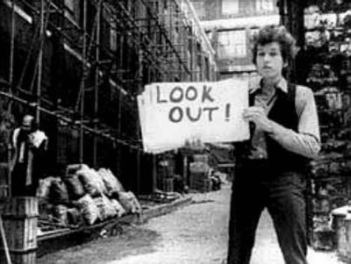 Euan MacDonald‘s headless tribute (the video, Where Flamingos Fly, 2005) has no similar loose ends. MacDonald eliminates what he can, including, on occasion, the point.
Euan MacDonald‘s headless tribute (the video, Where Flamingos Fly, 2005) has no similar loose ends. MacDonald eliminates what he can, including, on occasion, the point.
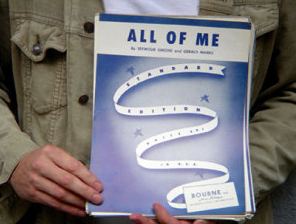 At the opening of MacDonald’s exhibit at Western Bridge, A Little Ramble, bewilderment prevailed. The question in the air could be succinctly summarized as, What?
At the opening of MacDonald’s exhibit at Western Bridge, A Little Ramble, bewilderment prevailed. The question in the air could be succinctly summarized as, What?
MacDonald’s work is full of narrative, but its connections with
hundreds at a party are hard to discern. He makes sense one on
one. In a crowd, his work is mute, even when it’s taking up almost all
the room.
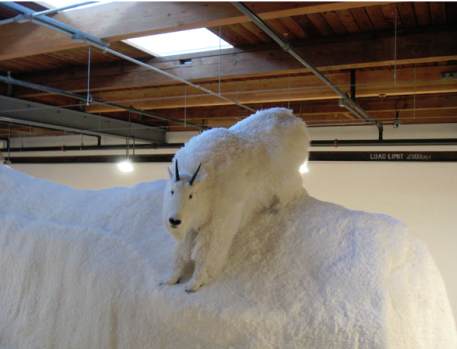 One
One
on one, however, a mood emerges. The birds have eaten the bread crumbs
leading out of the forest. No, they’ve eaten the forest. It’s there and
not there. What swells around the consciousness of the solitary viewer
is anti-climatic. The artist who isn’t there is a tour guide to a
mystery. In his absence, he left notes for a reassuring brochure. These
notes might be helpful. They look as if they are intended to be
helpful, but they’re in code.
The artist is cooler than the
viewer. His dry sense of humor makes light of the viewer’s predicament.
The viewer is Rosencrantz or maybe Guildenstern, and the artist is Tom
Stoppard. The former do not undestand their lives. The artist is not there to help them.
The New Poem
Charles Wright
It will not resemble the sea.
It will not have dirt on its thick hands
It will not be part of the weather.
It will not reveal its name.
It will not have dreams you can count on.
It will not be photogenic.
It will not attend our sorrow.
It will not console our children.
It will not be able to help us.
MacDonald’s
focus is the ordinary set askew. Two goats taking a little ramble on a
mountain top could not be more banal for the goats, but stuffed and
poised on a mountain of fake snow in an art center, they are oddities
supreme. Context obliterates the link to a natural history diorama.
While they lack the madcap exuberance of Robert Rauschenberg’s
paint-splattered and tire-clad emblem from 1955 (Monogram), they can be
nothing other than art, by context and by artist’s choice.
Selected Standards (2007) is the back story for the video, Where Flamingoes Fly. The standards flank the video in a gallery – 84 graphite drawings or black & white
photographs each paired with a sheet music for a once popular song. Again at
the opening, people puzzled over the connections between drawing,
photograph and sheet music. Left brain, right brain? Structured
landscapes, dated tunes? Earth and air? Work and romance?
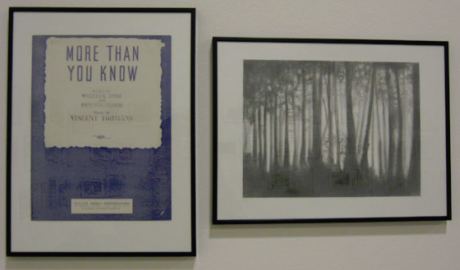
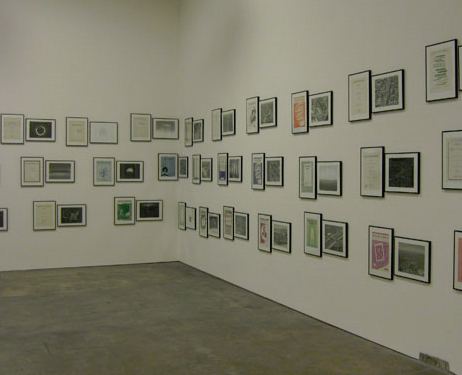 MacDonald found the sheet music in a second-hand store in Los Angeles, bought the lot and presented it in Where Flamingoes Fly more or less in the order he was given. Instead of Dylan’s groundbreaking Subterranean Homesick Blues,
MacDonald found the sheet music in a second-hand store in Los Angeles, bought the lot and presented it in Where Flamingoes Fly more or less in the order he was given. Instead of Dylan’s groundbreaking Subterranean Homesick Blues,
MacDonald rifles through the equivalent of musical wallpaper, each tune
played on piano as each sheet replaces the preceding. Here’s the curve
ball: Instead of numbing, the video is quite lovely. If this is the
musical wallpaper of our grandparents lives, they lived inside an
illumination.
World Reversal (12 ink-on-paper drawings, 2003) and The Shadow’s Path, 2003 treat the earth as another roadside attraction, quite haunting. I love the video, Three Trucks, a musical show down between three ice cream trucks. It’s entirely ordinary, but the effect is exhilarating.



The flash-card presentation of the Dylan tune Sub/hmsck/bls is entitled “A Chain Of Flashing Images” and is shown in the film “Don’t Look Back”.
I think this review is too much “Welcome to the Dark Side.” I find this artist downright cheerful.
Eloquent review, Regina. I could make neither head nor tail of that show. I know it’s only your opinion, but I didn’t have one at all. Now I feel like going back and developing one.
Dry roots.